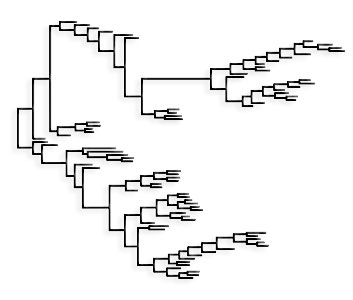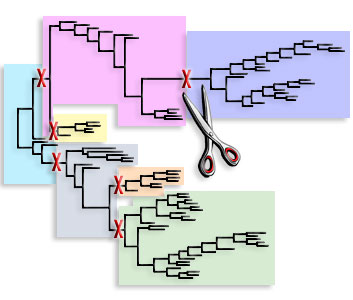Dividing the Tree: Planning What Goes on Each Page
The Tree of Life project takes the entire phylogeny of living things, and divides it into pieces, with each piece being presented on a branch or leaf page. One of the most important decisions to be made in planning Tree of Life pages involves this chopping up of the larger tree in pieces. If this were a piece of the phylogeny:

we might break it into seven pieces, each on its own page:

For some groups, the boundaries and terminal taxa for an individual Tree of Life page may be obvious. However, in many cases there will be several different ways in which a group could be subdivided, and authors have to decide which arrangement is the most appropriate. Here, we suggest some guidelines for dividing the tree into pages:
- Establish branch and leaf pages only for groups that are well-established as monophyletic
- In general, groups represented on the Tree of Life should be monophyletic. The more firmly established the monophyly of a group, the better it is as a candidate for a Tree of Life page. We realize that well-established monophyly is not a realistic condition for subdividing many difficult groups. If you must include groups which are probably not monophyletic, please indicate this clearly in the tree or taxon list (see Tree/Taxon List Formatting).
- Establish separate pages for prominent groups.
- When planning a Tree of Life page for a given group, please keep in mind that the information provided on this page should focus on the group as a whole. Your treatment of the group should be balanced, avoiding any bias towards taxa that are better known, more speciose, or simply more interesting. If you are tempted to go into too much detail about certain subgroups, you should consider creating separate pages for these groups. This will then allow you to give them the attention they deserve.
- It is also a good idea to create separate pages for those groups that have interesting characteristics which you want to say something about. For example, David Maddison subdivided the insect pages so that there is an insect page (an obvious break in the tree), a pterygote page (as origin of wings is something cool to talk about), a neoptera page (as neopterous versus paleopterous wings is a big deal), and so on.
- Subdividing the tree at each node that is associated with an interesting new trait can lead to pages with very few terminal taxa. The Craniata page, for example, has only two terminal taxa, the vertebrates and the hagfishes. The Craniata and the Vertebrata breaks in the tree are justified because the evolution of both the skull and the backbone are important topics deserving ample treatment in the Tree of Life.
- Don't worry about taxonomic ranks when dividing the tree.
- The terminal taxa on a Tree of Life page do not need to be of equal taxonomic rank. For example, on the Frogs and Toads page, species and genera happily coexist alongside families as well as taxa of other taxonomic ranks. This choice of terminal taxa is appropriate because the Tree of Life project focuses on phylogenetic relationships rather than taxonomic categories. In many groups, breaking the tree, for example, at the family, subfamily, and genus level will be appropriate; in others, it will make more sense to select different levels of taxonomic resolution for different subgroups.
- One thing that you should never do is establish more than one page for a monotypic taxon. For example, the Tree of Life page for the vampire squid represents the rank of the species, Vampyroteuthis infernalis, the genus, Vampyroteuthis, the family, Vampyroteuthidae, the order, Vampyromorpha, and anything a dedicated Linnean would want to recognize in between. All these names and different ranks apply to a single taxon, however you want to call it, and the characteristics of Vampyroteuthis infernalis will be the same as those of Vampyroteuthis and the Vampyroteuthidae–at least until additional species of Vampyroteuthis are discovered. Therefore, there should be only a single node for this group in the Tree of Life.
- Divide the tree so that there are not too many terminal taxa on any single page.
- Ideally there should be no more than 20 terminal taxa on a Tree of Life page if a tree is shown, 40 if a taxon list is shown. If numbers are higher than this, you should consider breaking your group into multiple pages. In some circumstances, there will be no natural way to break up a group. If this is the case, it may make sense to move some of the taxa onto a separate page, even if this will result in creating a page for a group that is certainly not monophyletic (e.g., The other protists).
 Go to quick links
Go to quick search
Go to navigation for this section of the ToL site
Go to detailed links for the ToL site
Go to quick links
Go to quick search
Go to navigation for this section of the ToL site
Go to detailed links for the ToL site